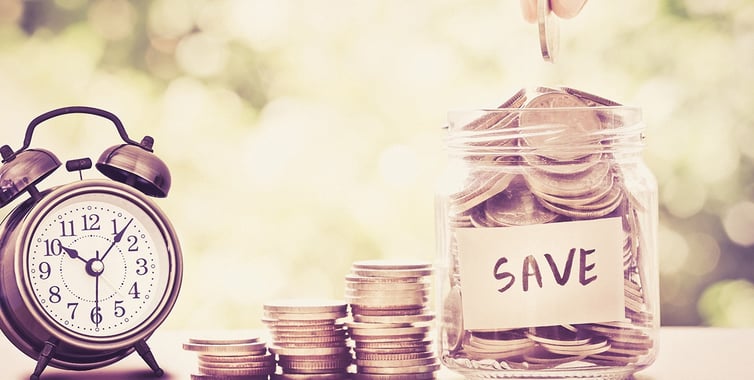Are you considering buying a boat or camper, installing an in-ground pool, or remodeling your kitchen, bathroom, or basement? Maybe taking your family to Europe or gifting your parents a cruise for their anniversary is one of your goals.
Is it one of your priorities to make a large donation to a charity in the near future? Your current biggest wish might be getting rid of hand-me-down living room furniture and buying something new.
We all have "wants," and some things we wish to do or have are expensive.
While saving a down payment for a home or car and putting away money for a child's education are considered "needs" by some, you might also include them in the want category.
No matter the big expense or purchase you'd like to make, it's essential to consider how you'll pay for it. Read on to learn more about ways to finance a considerable cost and the pros and cons of various options to fund things you want.
First Steps First
There are essential steps to take before you head to an RV show, search for flights and accommodations, or spend hours researching the type of kitchen cabinets you want. While being excited about your wants is fine, you can minimize regretful spending by practicing patience.
"Be patient, therefore, brothers, until the coming of the Lord. See how the farmer waits for the precious fruit of the earth, being patient about it, until it receives the early and the late rains. You also, be patient. Establish your hearts, for the coming of the Lord is at hand." James 5:7-8
Values-based Spending
The first thing you should do is consider how this significant expense aligns with your values.
Money isn't a goal - it is a tool to help you reach your goals and do what's important to you to live your most meaningful life. Your values guide your financial goals and daily actions to reach them.
If you haven't written a financial mission statement, we urge you to consider writing one as a way to ground your beliefs. This statement outlines your household's mission, purpose, and reason for being financially secure.
Download our free template that provides examples of financial mission statements and shows you the 4-step process to create one.
Check-in With Your Budget
The next item on your to-do list is reviewing your current budget, spending, and savings goals.
Are you generally sticking to your budget? Do you have months with a surplus, or are you consistently over your planned budget? You must be honest with yourself about the dollars that come and go in your household.
If you haven't been that careful or aren't sure where you stand financially, it's time to tackle budgeting and expense tracking to achieve financial success. There are terrific online tools and calculators to help you manage your money. Adding another high cost may affect your ability to meet other short- and long-term financial goals.
For example, remodeling your basement, so your teens have a place to hang out with friends may be important to you. But the money you'd spend to make significant changes to your home might impact how much you can put in your teen's college fund.
With a better understanding of your monthly expenses and overall finances, you can decide what trade-offs are worth it and when to pass on making a sizeable purchase.

Be Realistic About the Cost
If your "want" is something you still wish to pursue, now is the time to figure out the cost. Don't make the mistake of estimating expenses.
An in-ground pool must be filled with water, cleaned, and maintained with chemicals. You may encounter unexpected electrical or plumbing issues as you remodel your kitchen. And the saying that "BOAT stands for Bring Out Another Thousand" exists for a reason.
Consider other options if you decide your "want" is too expensive for your budget.
You may be able to afford a new couch, but not the coffee table, end tables, and lamps you saw on display. Rent a boat in the summer to reach your goal of being on the water. Update a bathroom with new paint, hardware, and towels. Scratch your "travel itch" with a road trip to a nearby state.
It may not be exactly what you desired, but tweaks to your wants can also produce positive results.
Warning: Wants Can Easily Multiply
When you started reading this article, you may have realized you have multiple "wants" that are expensive. And this is common!
You dream of spending summer days in your new pool or nights in your new camper, but you can't stand the thought of one more year with old furniture or skipping your vacation to somewhere warm during the winter break.
You get the idea. Spending can get out of hand quickly if you don't take the "first steps first" described above for each big want you have. Prioritize, consider your options, and manage your finances diligently to keep from taking on too much debt.
Paying For Your Wants: What Are Your Options?
At this point, you've decided to make your "want" a reality. When a significant expense or purchase is in your future, it's time to consider your payment options. Most people will have to choose one of the following ways to fund their wants:
● Pay in cash
● Finance the purchase
● Use a combination of cash and credit
Many variables may affect your decision. For example, paying in cash might not be an option if your timeline is short and a low credit score or limited credit history prevents you from financing a considerable expense.
Let's take a deeper look into these payment choices, the pros and cons of each, and tips and information about using each option to fund your expense.
1. Paying in Cash
"Debt is dumb; cash is king" is a favorite saying of money guru Dave Ramsey. Dave's standard advice is to put extra cash aside each month until you save enough to pay for your want.
And it makes sense that you'd want to pay cash and avoid interest charges to pay for an expense that isn't a need.
(Note: Paying "cash" may mean you will use physical money. But you could cover your costs with an electronic funds transfer from a savings or checking account through the Automated Clearing House - or ACH. You could even use a credit card if you pay off the entire balance when the payment is due.)
"The rich rules over the poor, and the borrower is the slave of the lender." Proverbs 22:7
Pros
The most significant benefit of this approach is that you won't be in debt. Your expense is paid in full and you won't have stress over making payments on it for months (or years) to come!
When you can resist the temptation to make a purchase you can't pay for in cash, you're practicing patience and delayed gratification.
Saving up money also provides a time buffer to make your final decision. Your attitude toward the expense or life circumstances may change, affecting whether you follow your original spending plan.
You may earn cash back or rewards points if you put the expense on a credit card. (Remember - any bonus you get by using a credit card will be wiped out quickly if you can't pay it off and get charged double-digit interest on your balance.)
Cons
The biggest drawbacks to paying cash are that it can take a lot of time, motivation, and perseverance to save up money in a monthly budget to pay for a large purchase.
Another disadvantage is that you may miss some opportunities by putting off the purchase. You may miss your teen's "hang out" years by the time you have the funds to remodel the basement. And the cruise you want to send your parents on may not happen if their health fails.
Tips for finding success with this strategy:
1. You already determined what your "want" costs. Now, it's time to carefully examine your budget to figure out a realistic goal. Keep budget lines that cover your needs and think twice before lowering how much you save for other critical long-term purposes such as retirement savings.
2. Consider how you can generate more income toward this goal. Depending on your life circumstances, consider the following:
● asking for a raise
● working a few extra hours each week (over-time)
● taking on a side hustle, seasonal position, or part-time job for some time
● selling items you no longer need or use
3. Make sure the separate savings you're putting toward this goal is also making money. The national average yield for savings accounts is less than .25%, and many traditional banks offer APYs in the range of .01-.05%.
If you haven't opened a high-yield savings account, now is the time to do it. It only takes a few minutes to open an account that can earn you close to 4% interest on your money. Online lenders such as Ally and CIT Bank tend to offer the best interest rates and are great banks to stash your emergency fund too. Setting up a direct deposit of your money into a high-yield account is well worth your time.
A Certificate of Deposit (CD) is another choice for keeping your emergency savings or accumulating extra money for a major purchase. However, many don't pay interest rates much higher than a high-yield savings account. CDs have terms ranging from one month to 10 years, and there are now options without early withdrawal penalties and bump-up rate options. Online lenders usually offer the best rates on CDs too.
2. Financing the Purchase
Using any credit is likely your most expensive payment possibility, and that's because you'll be paying interest rather than earning it.
Despite an increased cost, there may be particularly good reasons to finance your large expense. However, you must understand not just interest rates but the terms and fees related to several types of financing.
You'll need to pay special attention to early payment penalties, deferred interest, grace periods (and when you can lose them), and more.

Pros
The most significant benefit of using credit for your big expense is no long wait to buy it. If you're qualified, you can often get same-day financing. Even if you can't get it within a day or two, it'll likely only take a couple of weeks to approve and deposit your funds.
When you can buy or order what you want without waiting, you're likely to get precisely what you were looking for or be able to do what you wanted. You also don't have to worry about prices going up over time.
This may seem like a more "impulsive" approach, but it might make you happier, too (if you can afford the payments!)
Cons
As mentioned, you'll probably spend more (possibly a great deal more) to use financing over cash payment. This can be a genuine problem if you aren't carefully managing your money - especially if you use a home equity line of credit or loan because your home secures the financing.
If a financial "need" comes up (medical bills, loss of job) while you're still paying off your "want," you may also struggle to qualify for more credit and decent interest rates.
While you may get immediate gratification by taking out a loan or using a store line of credit, you may also have some regrets. Your feelings and attitude toward the purchase may shift in just a few months, and another big "want" could be more important to you. Having committed quickly to the first expense may limit your options.
Tips on finding success with this strategy:
1. Research various financing options for your purchase. These could include credit cards, home equity loans or lines of credit, personal loans, store, or dealership financing, long-term "Buy Now, Pay Later" plans, and more. It may take some work, but you could also save hundreds (or thousands) of dollars by learning what types of credit you should avoid.
2. With the average credit card interest rate now over 20%, it's likely the only strategy would be to use a card with a 0% APR introductory offer on purchases or balance transfers. But this is a risky strategy too.
Lenders generally offer a 6 to 21 months promotional period before standard 20%+ interest rates are tacked onto unpaid balances. You can also lose your promotional period for delinquent payment, and balance transfer cards have other fine print you need to understand about using the card for added purchases.
Related reading from the Consumer Financial Protection Bureau (CFPB): You Could Still End Up Paying Interest on a Zero Percent Interest Credit Card Offer.
A 0% credit card may work in some instances where you understand the terms and can pay off the debt before the promotional period ends.
3. As mentioned above, there are several variables to consider when using your home as collateral for a loan. Home equity loans and HELOCs (lines of credit) may work if you’ve built up equity in your home and aren't worried about making the payments - even in an emergent situation.
Depending on your chosen product, interest rates will be fixed or variable, and you'll generally be offered lower rates than other financing options. The use of the funds also determines if the interest is tax deductible.
This Federal Trade Commission (FTC) is an excellent guide to Home Equity Loans and HELOCs.
4. Both traditional and online lenders offer personal loans for these types of expenses. Some lenders even provide specific terms based on what you are buying or spending the money on (pool loans, boat loans, remodeling loans, and more.)
A Bankrate study shows that the average personal loan interest rate is over 10%. You may score a loan with single-digit rates with good to excellent credit, a low debt-to-income ratio, and a strong income and employment history.
5. Store or dealership financing needs to be carefully investigated. You must understand what it means if you're buying new furniture and get a "special financing" 0% deferred interest option.
According to the CFPB, "Deferred interest means that if you do not pay off the entire balance of the promotional purchase you've made on your card, then interest going back to the date of the purchase will be added on top of the remaining balance. This promotion may also require you to meet other terms, such as making your minimum monthly payments on time."
Boat or RV financing may look attractive at a dealer, but it can also affect your ability to negotiate better terms on your purchase. Dealers may receive a commission on loans, which can affect your interest rate. Ensure you can't get a better deal with a local credit union or online lender.
6. Have you been offered the chance to pay recent credit card purchases off over time? Buy Now, Pay Later (BNPL) is a popular way to extend payments on things you buy for a few extra weeks - usually with no interest.
But be careful because some BNPL products charge interest at exceedingly high rates. For example, on Uplift, you'll see this statement: "Actual terms are based on your credit score and other factors and may vary. APRs range from 0% to 36%."
3. Using a Combination of Cash and Credit
Combining the strategies above might make sense if you have some flexibility in your time horizon. You can save money for a down payment or put it toward the purchase, so you won't have to finance the total amount.
You could choose this path from the start or adopt it if your circumstances change, or you lose patience before your savings are fully funded.
The pros and cons are still similar to the ones listed for each strategy above. But this plan may work best if a couple has vastly different spending preferences (one saver, one spender) as it is a more balanced approach.
"Be completely humble and gentle; be patient, bearing with one another in love. Make every effort to keep the unity of the Spirit through the bond of peace." Ephesians 4:2-3
It's also an option if you have multiple "wants" on your list. The initial time you spend saving could help clarify what purchases you really want to make, and then you can divert saved funds to what you want the most.
Tips on finding success with this strategy:
While you may still pay more using this strategy versus paying in cash, it may also help you find a healthy balance when spending money on things that matter to you.
If you have a partner, communicate to find a "middle ground" you can both be satisfied with to avoid conflict over your savings progress and the overall expense.
Final Thoughts on Funding Your Wants
Even if you've adopted a Christian minimalist lifestyle, you'll likely have plenty of things you want to do or purchase throughout your life.
If you've written a financial mission statement or practice values-based spending, use a budget or expense tracker, and have a good handle on your financial health, you'll likely make a large purchase with great caution.
Whether you decide to save up, use credit, or combine the two, the cost will be worth it when you (or a loved one) enjoy your purchase.













Comments